Mauve 1/48 P-40N-20CU Warhawk
The final development of the P-40 series to see operational service and combat, the P-40N-5 appeared in 1943. Unlike the earlier P-40N-1, it came with the six gun armament. It differed from the earlier sub-type with a different canopy with a clear fame and a “wrap around” rear vision section (this canopy section is frequently shown with framing; however, it was frameless other than for Plexiglas stripes over the individual Plexiglas sections, which reflect light differently and have been mistaken for framing, in the same way similar frames on Plexiglas gun turrets have been mistaken for framing). The P-40N-5 saw service with the RAF, RAAF and SAAF in Italy and with the RAAF in the Southwest Pacific Theater. It's primary combat use by the USAAF was in New Guinea with two squadrons of the 49th Fighter Group and in the CBI.
The Chinese-American Composite Wing:
The USAAF commitment to China expanded in September 1943 with the formation of the Fourteenth Air Force, which greatly expanded Chennault's China Air Task force with the addition of the 51st Fighter Group to the 23rd FG, P-38s from the 449th Fighter Squadron, and B-24s of the 308th Bomb Group. The force was organized into the 68th Composite Wing with the 23rd Fighter Group's P-40s, the 449th's P-38s, and the B-25s of the 11th Bomb Squadron with responsibility for operations in eastern China. The 69th Composite Wing, tasked with defense of the Hump bases, with the P-40s of the 51st FG and B-25s of the 341st Bomb Group.
A third composite wing was formed at this time at the training base outside Karachi, which was unlike any other unit to see combat during the war. Chinese pilots of the ROCAF had been training in the US since 1941, but ROCAF units had played little part in the war in China after the arrival of the USAAF. Chennault was reluctant to assign these US-trained pilots to the moribund ROCAF units, and suggested that a composite force of these US-trained Chinese pilots and USAAF pilots be formed. Since the USAAF was experiencing a personnel shortage, the idea was accepted.
Chinese pilots who had flown with the 23rd FG in 1943 were assigned a flight leaders and squadron commanders. The command structure would have a Chinese and an American officer in each leadership position from flight leader to wing commander. The aircraft were the property of the ROCAF, supplied through Lend-Lease.
By the fall of 1943, the 3rd and 5th Fighter Groups, composed of four squadrons each equipped with P-40Ns, and the 1st Bomb Group, composed of four squadrons of B-25Js, had been formed and trained and had moved to Kweilin in southeast China.
The Japanese “Rice Bowl Offensive” began in November 1943, and all units of the Fourteenth Air Force were soon in action. The CACW 3rd Fighter Group entered combat in December 1943, scoring nine victories in the course of the month. By January, the offensive had slowed and stopped, but the greatest combat of the war in China lay ahead in the coming year.
The Ichi-Go offensive, designed to conquer all of South China, began in April 1944. Initial success forced evacuation of all airfields in southeast China. The offensive continued throughout the year. By June, the Fourteenth Air Force had been forced to withdraw from nearly all the forward bases, and in September an additional Japanese offensive from Indochina forced withdrawal back to the original bases around Chungking.
The CACW 3rd Fighter Group was sent north to oppose an advance in Honan Province. The American commander of the 7th Fighter Squadron was LCOL William N. Reed. Reed had come to China with the AVG and had flown in the 3rd “Hell's Angels” squadron, where he was credited with three aerial victories and the destruction of eight enemy aircraft on the ground during an attack on the Japanese base at Moulmein with Ken Jernstedt on March 8, 1942.
Reed returned to China in early 1944 as a USAAF Major and was placed in command of the 7th FS, which entered combat on May 5, 1944. Reed opened his score on May 16 with two shared victories and two solo victories. Six of the Chinese pilots in the squadron also became aces during these combats.
On October 27, 1944, Reed led 16 rocket-equipped P-40Ns on a train-busting mission to Hankow. After thoroughly shooting up a train south of Hankow, Reed led the formation over the Japanese airfield at Kingmen, where nine “Lily” bombers and ten “Oscar” fighters were circling to land. Reed, now a LCOL, shot down a “Lily” for his sixth and final victory, making him the squadron's leading ace with a score of nine. The pilots scored 16 victories in the fight, with top-scorer Lt. Wang Kuang Fu sharing one Oscar and shooting down two Oscars and a Lily alone. These were the unit's last victories of 1944. Two months later, on December 19, 1944, Bill Reed was killed when he tried to bail out of his P-40 and struck the horizontal stabilizer. He was a month shy of his 28th birthday and the most-decorated American pilot in the CBI.
The Chinese pilots who flew with the CACW would become the leaders of the ROCAF in the years after the war.
The P-40N-5 was the first kit released by Mauve during its short existence. It is still one of the best kits of the final version of the P-40, though it needs the True Details resin cockpit and the Squadron vacuform canopy to provide interior detail that equals the external detail. Fortunately, several decals sheets were released by Aeromaster, Eagle Strike and Super Scale for the kit, which is nice since there were a lot of interesting markings that appeared on these airplanes in the various air forces they served with.
The Mauve kits are easy to build, there are none of the “inserts” one finds in the Hasegawa P-40s. There is more detail in the Hasegawa kits in terms of the nose radiator, a better tailwheel, etc., but nothing major.
I assembled the wing and fuselage sub-assemblies, then painted the resin cockpit and assembled it, then fitted it in the fuselage. I found it was useful to put a spreader bar in the fuselage aft of the cockpit, using a piece of cut-down sprue, to get a good join of wing and fuselage. I trimmed and fitted the Squadron vacuform canopy windscreen and glued it in place with C-A after dipping in Future to avoid fogging.
With care in assembly, I only needed some Mr. Surfacer on the fuselage centerline and the upper wing/fuselage join. After attaching the horizontal stabilizers, the model was ready for painting. I used prop blades for an Eduard P-39Q (4-blade prop version), which replicate the “paddle” blades used by the P-40N.
The rocket tubes came from the recent Airfix P-51D kit.
I used Tamiya Neutral Grey and my mixture of Tamiya “Khaki Drab,” “Flat Earth” and a bit of “flat Yellow” to create brown-drab late war Olive Drab. These were free-handed, and both colors were post-shaded. I used Tamiya “Flat Green” for the medium green blotches on the leading and trailing edges of the flying surfaces that Curtiss painted their P-40Ns.
The decals came from the same sheet I used to make the earlier P-40N, which had the markings for LCOL Reed's “Boss's Hoss.”
It's really too bad Mauve was destroyed by the Kobe earthquake, since these P-40s show they would have been a contender had they continued. The kits are available from dealers on eBay and are far less expensive than Hasegawa kits (if you can even find their P-40N), even with the additional cost of the True Details cockpit and Squadron vacuform canopy. They present no difficulties and make up into a good model.
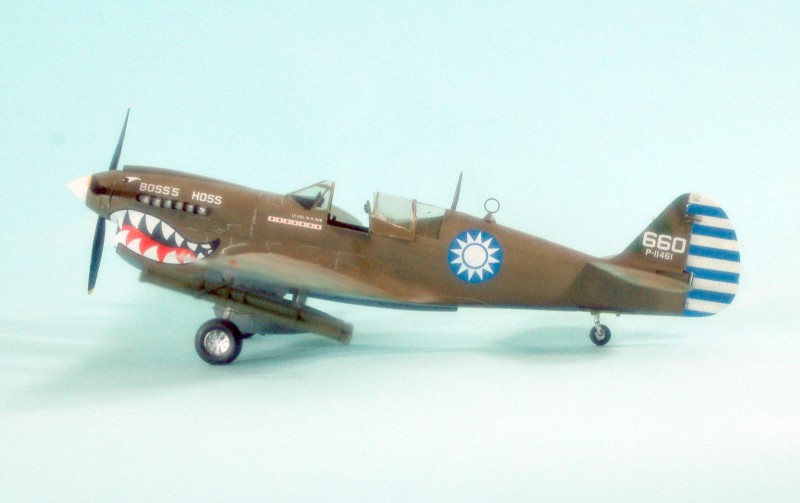
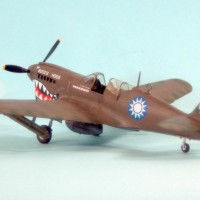
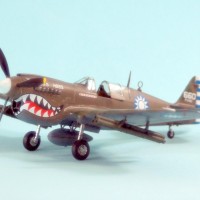
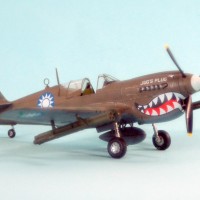
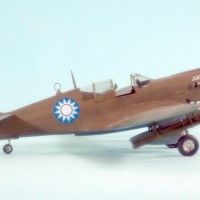
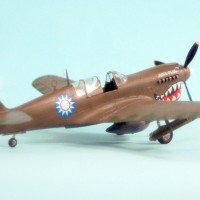
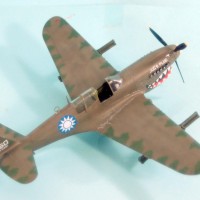
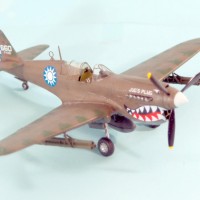
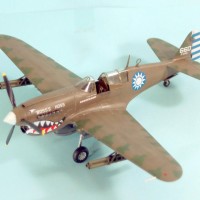
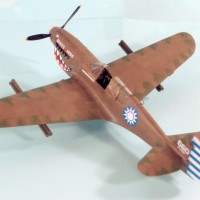
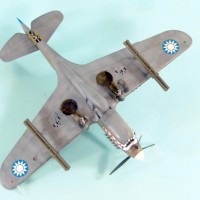
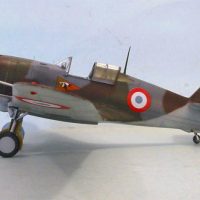
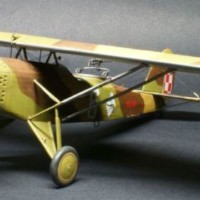
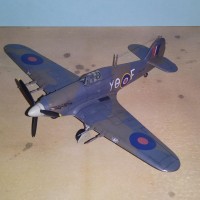
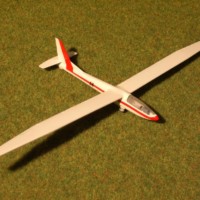
Good-lookin' build, TC...
I know the "Big Three" (P-51, P-47, and P-38) are prominent for very good reasons, the P-40 to me just screams consummate WW2 fighter. And yours is a beaut.
I’ve never seen a P–40 with bazooka tubes . Very interesting build.
After the summer of 1944 when the 49th Fighter Group gave up their last P-40Ns and went all-P-38, China was the last place where the P-40 was used in combat. As they got P-51s, P-47s and P-38s, the P-40Ns were pushed to ground support, and the plastic rocket tubes were among the few items the P-40 could carry underwing - they were able to carry these and a 250-lb bomb underwing, making them worthwhile ground attack aircraft.
Tom, another good looking P-40!
Like Mark said, I too never saw that ordnance hanging from a P-40 with just makes your model more unusual.
Very well painted, and the Chinese markings/sharkmouth combo makes her an instant classic.
Now for those like me who don’t have English as native language, what’s the meaning of “ Boss s Hoss”? Sounds slang for boss’s horse
That's exactly right - boss' horse.
Great model and thanx for the history provided. I never knew the Chinese used this version of the P-40.
Boss's Hoss / Jug's Plug ! Great P-40, Tom ! Very interesting history as well. I love seeing shark-nosed Warhawks with Chinese markings. Lots of history.
Man, that's a really cool scheme for a P-40! May have to add that to my bucket list. Great model Tom.
Those markings look really good, my Chinese friend likes this one very much.